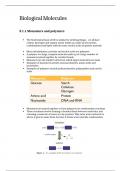Biological Molecules
3.1.1 Monomers and polymers
The biochemical basis of life is similar for all living things – we all have
carbon, hydrogen and oxygen atoms within us, made up of proteins,
carbohydrates and lipids with the same nucleic acids as genetic material
Most carbohydrates, proteins and nucleic acids are polymers
A polymer is a large, complex molecule made up of a large number of
monomers joined together by covalent bonds
Monomers are the smaller units from which larger molecules are made
Examples of monomers include monosaccharides, amino acids and
nucleotides
Examples of polymers include polysaccharides, polypeptides and nucleic
acids
Monomers are joined together to form polymers via condensation reactions
These reactions involve forming a chemical bond between molecules, and
releasing a molecule of water as a by-product. This extra water molecule is
where it gets its name from, because it forms water just like condensation
, The polar opposite of condensation is hydrolysis
In hydrolysis, water is used to break down polymers back into their
individual monomer molecules by breaking the chemical bonds between the
different monomers
This again can be derived from the name: hydro meaning water and lysis
meaning “splitting up”
,3.1.2 Carbohydrates
All carbohydrates only contain C, H and O atoms
The monomers that larger carbohydrates are made from are
monosaccharides
Glucose, fructose and galactose are all examples of monosaccharides
Many monosaccharides can undergo condensation to form a polysaccharide,
and 2 monosaccharides react to form a disaccharide
Glucose is a hexose sugar because it is a monosaccharide with 6 carbon
atoms
Glucose has two isomers (versions of the same molecule with the same
molecular formula (C6H12O6) but different structure): alpha-glucose and
beta-glucose:
Although the spec shows a simplified version, it is best to draw glucose
isomers as shown above
There is an easy way to remember/draw these molecules:
Alpha: down, down, up down
Beta: up, down, up, down
, First, you start off by drawing the 6 carbon atoms and oxygen in a hexagonal
shape:
Then, starting from the right-most carbon, draw the OH groups in the
following order:
For alpha: down down up down
For beta: up down up down




